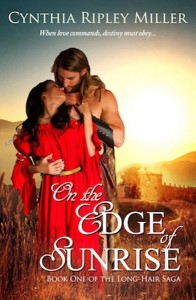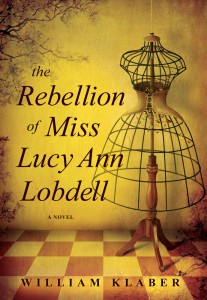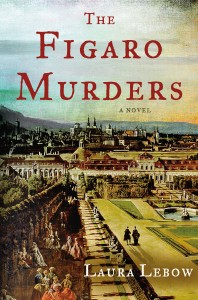New Voices: William Klaber, Laura Lebow, Cynthia Ripley Miller & Eleanor Parker Sapia
by Myfanwy Cook
 William Klaber, Laura Lebow, Cynthia Ripley Miller & Eleanor Parker Sapia unveil engaging insights into the intriguing characters and historical periods they explore in their debut novels.
William Klaber, Laura Lebow, Cynthia Ripley Miller & Eleanor Parker Sapia unveil engaging insights into the intriguing characters and historical periods they explore in their debut novels.
Cynthia Ripley Miller’s debut novel, On the Edge of Sunrise (Knox Robinson, 2015), is set in France during the Merovingian era. “It is a romantic adventure about Arria, a Roman senator’s daughter, and Garic, a Frank First Counsel to his tribe,” she writes. “Their ‘love at first sight’ desires force them across cultural boundaries, into political intrigue, and against Attila the Hun. I grew up with an Old World grandfather who loved to tell a story. As a girl, I read a lot, leaning toward the historical, and eventually became an English teacher. I joined writing groups and wrote short stories, but dreamt of writing a book one day.”
However, Miller’s love of strong and powerful characters only came to the fore some years ago, she says. “With a hectic school year completed, I wanted a break from educational textbooks. I looked for a historically-set novel with an adventurous plot. I guess one might say I turned to the dark side: genre fiction. Anne Rice’s vampires brought historical backgrounds to life and demonstrated a diversity of human traits despite their undead status. Diana Gabaldon and her Outlander series captured my attention with their vibrant characters, Scottish history, and splash of fantasy. These stories inspired me because they possessed the elements that appealed to my personality. I felt compelled to move in the direction of a well-researched romantic historical and sought to create a new, uncharted setting for my novel. Yet at the same time, I wanted to write in a world somewhat familiar to me.
“From my travels abroad, ethnic heritage, and some experience teaching history, I decided ancient Rome would become my backyard. I wanted a turbulent and exciting time span that would cross cultures and usher in the medieval age. From a writer’s perspective, 5th-century Rome, and the Germanic barbarian Franks – who later became the French Merovingians – filled the niche for drama, intrigue, and a fresh era. Who were these barbarian warriors and nobles who began to flourish and dominate the European landscape? They beckoned me.”
 The main character of The Rebellion of Lucy Ann Lobdell (St. Martin’s Press, 2015) was introduced to William Klaber in a tiny town in upstate New York. He explains: “One morning, long-time local historian Jack Niflot asked me to lunch. Over a plate of hash and eggs, Jack told me about Lucy Lobdell, who had lived in town before the Civil War and who was said to have haunted my old farmhouse in the 1880s. I had never heard of her. Jack said that in 1855, Lucy cut her hair, changed clothes and went off to live as a man. She opened a dance school and, after a disastrous romance with a female student, she fled with a rifle to the western frontier and passed for three years until she was found out and put on trial for the crime of wearing men’s clothes. Later she was married to a woman by an unsuspecting judge. Jack said he had been collecting material on Lucy for decades and showed me a leather satchel filled with letters, newspaper articles, and Lucy’s early writing. He said he was looking for someone to bring Lucy’s story forward. I was stunned, but I knew right away that I wanted to try.”
The main character of The Rebellion of Lucy Ann Lobdell (St. Martin’s Press, 2015) was introduced to William Klaber in a tiny town in upstate New York. He explains: “One morning, long-time local historian Jack Niflot asked me to lunch. Over a plate of hash and eggs, Jack told me about Lucy Lobdell, who had lived in town before the Civil War and who was said to have haunted my old farmhouse in the 1880s. I had never heard of her. Jack said that in 1855, Lucy cut her hair, changed clothes and went off to live as a man. She opened a dance school and, after a disastrous romance with a female student, she fled with a rifle to the western frontier and passed for three years until she was found out and put on trial for the crime of wearing men’s clothes. Later she was married to a woman by an unsuspecting judge. Jack said he had been collecting material on Lucy for decades and showed me a leather satchel filled with letters, newspaper articles, and Lucy’s early writing. He said he was looking for someone to bring Lucy’s story forward. I was stunned, but I knew right away that I wanted to try.”
Klaber started to work “on Lucy’s biography,” he says, “but there was a problem. With Jack’s research and my own, I could paint in broad strokes where Lucy went and what happened, but all the things we would really want to know – her thoughts, her words – these things were lost to time. There were rooms we could simply not enter. But that changed the moment I stopped writing her biography and started writing her memoir. Suddenly I was inside those forbidden rooms. Now all I had to do was to get Lucy to loosen up, talk to me, and tell me how it all went down. It took a long time, but finally she did.”
Like Klaber, Eleanor Parker Sapia found herself in a position where her characters almost insisted on being written about. She has “long believed,” she says, “that if we discover a truth and ignore it, the same truth will revisit us. Ignore that truth again, and its grip becomes tighter, never fully releasing us, because we know.
“The tribute I wrote in honor of my Puerto Rican grandmother’s 90th birthday, and a lifelong friendship with her Caribbean midwife, inspired my historical novel, A Decent Woman (Booktrope, 2015). I planned to write about the complex lives of women in male-dominated, colonial Puerto Rico, which would include racism, misogyny, and the social turbulence of the era, and I knew my protagonist, Ana Belén, an Afro-Cuban midwife, born into slavery, would confront male doctors entering the birthing room for the first time. But I did not set out to include an infanticide trial, prostitution, early feminism, and the forced sterilization of Puerto Rican in the early 1900s, nor did I anticipate adding crimes against women to the story.”
As Parker Sapia’s research continued “into the lives of women in turn-of-the-century Puerto Rico,” she writes, “It became glaringly obvious I couldn’t turn my back on what I’d discovered. I was now faced with historical truths, and at the time I was a Spanish-language refugee case worker and a counselor in Brussels, Belgium, working with women involved in human trafficking, in abusive relationships, and most of my clients were living on the fringes of Belgian society – it was imperative for my story to grow and evolve. The universal truth that pain is intensely entwined in the human experience spurred me on.
“It is my hope that through the readers’ empathy and identification with my characters and their unique experiences with pain and suffering, Caribbean women are properly honored and recognized through my storytelling. My character’s struggles are as familiar to women today as they were to the women of Puerto Rico’s past.”
 What inspired Laura Lebow to write The Figaro Murders (Minotaur, 2015), which is set in 18th-century Vienna, was initially an interest in opera rather than a specific character. She writes: “The inspiration for The Figaro Murders began 15 years ago, although I didn’t know it then. I had become an opera enthusiast, and was taking a university course on Mozart’s operas. I was fascinated by the operas and wanted to know more about how they reflected Enlightenment thought. I bought every book on the professor’s recommended reading list, read a few, and shelved the rest in my ‘to be studied when I retire’ bookcase.
What inspired Laura Lebow to write The Figaro Murders (Minotaur, 2015), which is set in 18th-century Vienna, was initially an interest in opera rather than a specific character. She writes: “The inspiration for The Figaro Murders began 15 years ago, although I didn’t know it then. I had become an opera enthusiast, and was taking a university course on Mozart’s operas. I was fascinated by the operas and wanted to know more about how they reflected Enlightenment thought. I bought every book on the professor’s recommended reading list, read a few, and shelved the rest in my ‘to be studied when I retire’ bookcase.
“Ten years later, I was looking for a new project to fill my days and decided to write a novel. Since I’d been a mystery and historical fiction fan since age six, I knew I wanted to write a mystery, to challenge myself to see if I could write a book as good as the many that had kept me enthralled since childhood. My thoughts returned to my bookcase full of studies of Mozart’s operas. Why not combine the two interests, and write a series of mysteries about the operas of which I had grown so fond?” Then, Lebow writes, “I chose Lorenzo Da Ponte, the librettist for Mozart’s three most famous operas, as my detective. Da Ponte was a talented poet who was forced by the vicissitudes of fate (and his own weaknesses) to leave his beloved Venice and make his way through Europe, reinventing himself after every setback he encountered. To me, he is a fitting representative of the dangers and opportunities of the enlightened 18th century.”
From a reader’s perspective, she treasures: “those historical novels that create a world for me, a world to which I long to return for days after I close the book for the final time. I wanted to create such a world for my own readers. So, after a year of reading all the books I had saved on my shelf, and many more, I finished my research by spending a week in Vienna, taking hundreds of pictures of buildings, streetscapes, and vistas, using my imagination to see the city as it was when Mozart and Da Ponte walked its streets.”
What Klaber, Lebow, Miller and Parker Sapia share in common is that by using their imagination and carefully researched backgrounds, they have provided their readers with a key to unlock the doors to places and ways of thinking in the past that would otherwise be sealed forever.
About the contributor: MYFANWY COOK admires the ingenuity of debut novelists and their ability to share new stories to entertain readers of historical fiction. Please email (myfanwyc@btinternet.com) or tweet (twitter.com/MyfanwyCook) about debut novelists you recommend.
______________________________________________
Published in Historical Novels Review | Issue 72, May 2015






